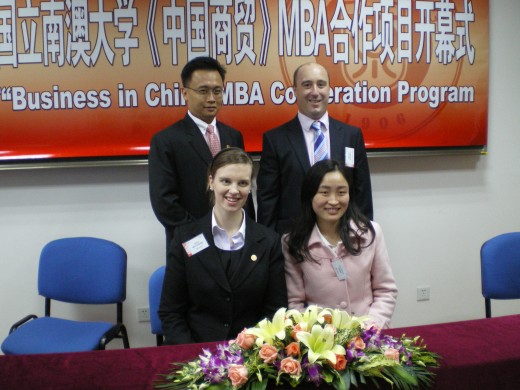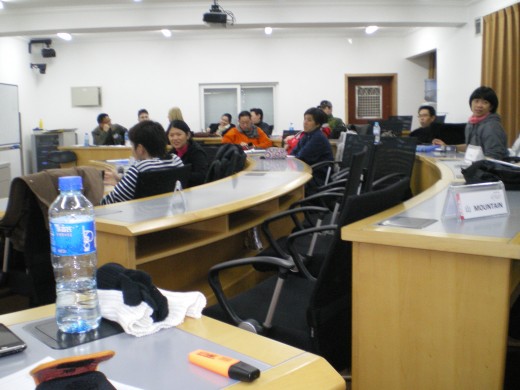Doing Business In China by Michael Kromwyk


How do you do business in China? This article is a how to guide of how to do business using a framework developed by Laubie Li from UniSA. This article uses the example of buying a mobility scooter from mainland China and importing it to Australia.
Industry Factors
Chinese industry is usually lo-tech importing high end component to install into machinery made in China. However, companies are starting to move into more high-tech a part of a planned Government strategy to develop more high technology products (Liu, 2007, p. 35) in China.
Similar to other Chinese enterprises the high technology components are not produced in China, but rather imported (Sull & Wang, 2005, p.5).
An example is mobility scooters. There are over 650 suppliers of mobility scooters in China with 500 in Shanghai alone. Most of the Shanghai locations are sales offices with factories in Guangdong. Guangdong also has another 113 Scooter companies based in the province (www.alibaba.com, 28/4/10). This means that there is competition for staff with so many companies competing in the area. The opportunity for foreign businesses is that with so many producers it should be easy to switch supplier providing that the mobility scooter build and the battery is identical to that being used by Crescive. Therefore switching costs will be low.
Market Factors
A major factor of doing business in China is the market. By using our mobility scooter example we can unpack this more. Many factories are located in Shenzhen in the South East corner of China. In 1980 Shenzhen was one of the four original special economic zones (Qian, 2000, p.155) developed by Deng during the reform period.
As Shenzhen was one of the first areas in China to open up it has considerable numbers of migrant workers from rural areas (Magni & Atsmon, 2010, p. 31). 93% of the 16 million population are migrant. There is a risk that if conditions and wages increase in their home cities, these staff may be flight risks leading to reduced staff production capacity for local factories.
In addition the future population of Shenzhen is predicted to fall by 7.5% in 2015 (Magni & Atsmon, 2010, p. 31). However GDP is predicted to remain buoyant with a growth of 4.3%.
The GFC has hit hard in areas such as Shenzhen due to the reduced demand for exports destined to developed nations. This has lead to reduced wages for workers and social unrest including mass protests in this region (Zhang, 2010, p.35).
Chou (2010) says that the best opportunities in China are west. Migrant workers are from these regions and if they can find suitable work in their homelands then there is a tendency for them to remain. The key opportunity for foreign companies is to plan for relocation into a western city such as Central or the Yangtze Mid/Lower areas that have both population growth and good consumer confidence (Magni & Atsmon, 2010, p. 30-31).
Political Factors
China and Australia have been in negotiation for a free trade agreement (FTA) since 2005. It has stalled mainly due to agricultural issues. Australia is generally in the top 10 trading partners with China (www.mofcom.gov.cn, 2010) and even with disagreements in some areas (such as Rio Tinto) the relationship is generally friendly.
However there are three risk factors for foreign firms – potential social unrest, Governmental policy change and the interpretation of policies and laws.
There is a growing divide in the nation’s wealth between rich and poor and this can lead to social unrest (Zhang, 2010, pp.30-31 & 34). This divide is also between cities and the poorer countryside. Saich and Shahid (2008, p.195) believe that this growing divide in addition to the social and economic problems faced by people could lead to social unrest in the future. According to Zhang (2010, pp. 84-87) technology, such as the internet is allowing people to become organized as well in regards to social problems and the gaps between groups of people. The Government has recognized this issue and has introduced reforms to counteract the GFC (Political Risk Services, p.19; Zhang, 2010, p.34) and social pressures. These reforms include upgrading the health system, health insurance and other social services. There have also been reforms in the countryside with increases in payments to farmers and incentives for people to stay in their homelands (Chou, 2010). As a result people in the west of China have more income and are becoming a target market for MNCs to sell into.
The other risk is that at times the Chinese Government may change policy and this can either affect the industry you are purchasing from or increase tariffs on components purchased off shore, such as motors. In China the Government is the pace-setter and guide for all enterprises and usually policy change occurs with little notice (Haggard et al, 1991).
The final issue is that central government policies and laws are subject to local interpretation and enforcement (Sull & Wang, 2004, p.4; Zhang, 2010, p.33) meaning that companies in Shenzhen could be operating under different rules than another manufacturer in the nearby city Guangzhou or another province.
Cultural Factors
Another aspect of doing business in China is how to develop a relationship or guanxi with the supplier. Initially the relationship that will form between the foreign firm and the Chinese supplier will be that of strangers working together (Luo, 2010). There will be no strong ties at commencement. The foreign firm needs to understand this and start developing some guanxi at the initial contact. The process could include:
• Site visit to the factory and tendering gifts to the senior Executives and staff dealt with on an ongoing basis (Duo, 2005, p.82). This is known as renqing (Luo, 1997, p.47)
• The next level will come after a longer term relationship which has been mutually beneficial to both companies (Duo, 2005, p.82). This trust is formed out of the ongoing relationship and regular visits to the factory.
Via frequent trips management will develop guanxi with the Chinese management and this can develop into one of the five relationships in guanxi; friend – friend (Luo, 2010). This can then develop from strangers into weak ties and finally familiar ties where trust and favour giving are commonplace (Luo, 2010). It also assists in the ‘gray’ areas of doing business in China, such as legal and governmental hurdles, to get the optimal position of maximising any return (Zhang, 2010, p.29)
The key outcome for the foreign firm is that over time trust and guanxi must be developed to ensure that it gains priority in production and a high quality product for each shipment.
Legal Factors
The Chinese commercial legal system is generally underdeveloped but is improving since WTO entry (Lapres & Zhang, 2008, p.10). This is a good result considering that there was no commercial law in China until 1978 (Zhengping, 2010).
According to Clarke (2003, pp. 108-109) there are three issues preventing China from attaining WTO compliance. They are:
• China has a poor legal system
• The authority levels of judges are limited and can be overridden by the Government
• A distinct lack of legal-trained judges
This means that there is a risk that if the agreement fails with the Chinese supplier, that the foreign firm may find it very difficult to pursue the supplier legally.
However since 2003 there has been some progress. In 2008 Lapres & Zhang (p.11) noted that there have been some major accomplishments in legal reform and that the Government is supportive of improved governance, an independent judiciary and effort to reduce corruption. Further, as civil law becomes more prominent in China the Government has plans to introduce laws on commercial secrets and Intellectual Property (IP) in the future (Zhengping, 2010), further mitigating risk for foreign firms.
In 2008 the National People’s Congress passed the Environmental Protection law and upgraded the National Bureau of Environmental Protection to a Ministry of Environmental Protection (Zhang, 2010, p.200-1). This indicates that the government is now focused on sustainable economic development and environmental protection. The relevance for foreign firms is that exporters can be barred for 3 years if they do not adopt the new standards (Zhang, 2010, p.200). There is a need to ensure that Chinese suppliers are compliant in any site visit.
A final factor is the recently introduced Labour Contract Law which protects staff from unfair dismissal and delivers a minimum wage (Jiang, 2010; Zhang, 2010, pp. 36-37). This is another risk that could affect suppliers in the future if they don’t manage their workforce legally. However the upside for foreign firms is if local suppliers do support the new laws the result should be a more motivated workforce and therefore less problems in quality or non-production.
While the legal landscape is changing for the better and reducing risks for exporters Professor Lu Zhengping advises that anyone doing business in China should seek a good lawyer. All foreign firms should heed this advice.
Financial Factors
At the commencement of the relationship it is imperative that the foreign firm protects their investment by not parting with any money until the goods are delivered and checked. The best way to handle this transaction is through a letter of credit or bill of lading (Hill, 2009, pp. 548-550). Credible International Banks such HSBC, NAB or the People’s Bank of China could be used as they are trusted by both parties. This could form a part of the contract.
Over time, even if guanxi is developed, it is important to ensure that a contract remains in place and that the finances are protected and released only at satisfactory delivery of the goods to the foreign host country port.
Another financial factor to consider for exports is the fluctuating exchange rate. At present $A1 buys RMB6.34 (www.xe.com, 22/4/10). Since 2005 the RMB has been pegged to a basket of currencies and is able to fluctuate daily in a range on 0.3% (USST, 2010). However in 3 years since the float the RMB has only appreciated 18% (www.safe.gov.cn, 2010; USST, 2010). Therefore the Government does not believe that the RMB is undervalued and is resisting US pressure to float the RMB. However, it is believed that either the Government will be required to increase interest rates or let the RMB appreciate (USST, 2010). This could have an adverse effect on any export as it would increase the cost of the landed good.
As previously discussed the GFC has adversely affected the manufacturers of this region and this is putting pressure on competitive advantage, profits and downward pressure on wages (Zhang, 2010, p.35). This is leading to social unrest and could adversely affect any suppliers operation in Shenzhen in the future.

Entrepreneurial Behaviours
Some Chinese businesses lack entrepreneurial ability due to cultural and recent political history (Zhang, 2010, pp.44-45), such as the Cultural Revolution. But a number of business do show attributes of entrepreneurial behavior in the diverse range of products that they produce and the way that they market their products on sites such as Alibaba.com.
There is a risk with dealing with a private company as entrepreneurs are not viewed highly in China (Liao & Sohmen, 2001, p.29). This is reflective of Confucianism philosophy where bureaucracy is viewed as the highest position in society whereas being a shop owner is the lowest role.
Innovation & Value-adding Preferences
Chinese companies are great imitators but have limited innovation skills in the past (Linden, 2004, p.6). Some of this is due to limited investment in innovation and R&D within organizations, low technological infrastructure and difficulties in knowledge transfer (Zhang, 2010, p.43). However this is starting to change, especially with returnees from overseas who are bringing new skills and innovation back to China (Linden, 2004, p.7).
Another reason, according to Li et al (2007, p. 81) is that most Chinese CEOs are only paid and rewarded for short rather than long term targets, which can thwart innovation in companies.
Foreign buyers can choose to assist Chinese suppliers in innovation by asking for product enhancements sourced by reviewing competitor models or from customer feedback. You can also encourage your supplier to move towards first generation complete participation (Li, 2010) in the relevant market. This means that the Chinese supplier commits to conduct R&D on the product, is able to imitate other brand developments and has the ability to create value adding features to the product that other companies will find hard to imitate, at the same time containing costs.
Technology Utilisation & Management Practices
Technology usage is starting to grow in China according to Zhang (2010, pp. 1-11) driven mainly through mobile phones and internet usage. There is a growing population that is technology savvy with 300 million internet users who are developing applications and building communities online. These people will drive technology usage and innovation in the future.
Another factor is SHRM. The ‘iron rice-bowl’ policy of a job for life has been abolished and this for the first time has allowed staff to be dismissed (Hassard et al, 2004, pp. 315-316), within the constraints of the Labour Contract Law. This has also lead to the introduction of western style SHRM into Chinese business. At some Chinese suppliers this signifies that they can hire people on contract for a set period of time and then terminate their services. It also allows for performance management to ensure quicker turnaround times and better quality output. While this benefits them in being able to respond to market conditions it can also lead to the inability to source new staff quickly.
Purchase and Fulfilment Process
Curt Shi, Venture Capitalist for IIP Capital, has advised that with any purchase transaction from China that someone who is trusted by the exporting organization reviews the products prior to shipping the stock. The process recommended is:
1. Agree on product specifications, trading terms, payment and price inclusive of delivery to the foreign nation
2. Production commences with QA completed across the order and documentation provided
3. Once the shipment has been produced, representatives from your company check the products including start up, test drive and QA
4. If entire shipment is at an acceptable standard then authorize to ship and seal the container, if not replace poor product and repeat the process
5. Double check in the final port and if all is in order release the letter of credit of bill of lading
6. For the next shipment employ a local person who you trust to complete step 3. Alternatively employ a trusted buying agent located in the region
7. It is recommended to regularly visit China, not only to check quality but to continue to develop guanxi (Duo, 2005, p.82) at least every 12-18 months.
I hope this blog has assisted you in buying and doing business with a Chinese supplier. Any feedback would be great and I am happy to provide any other research notes or comments.







